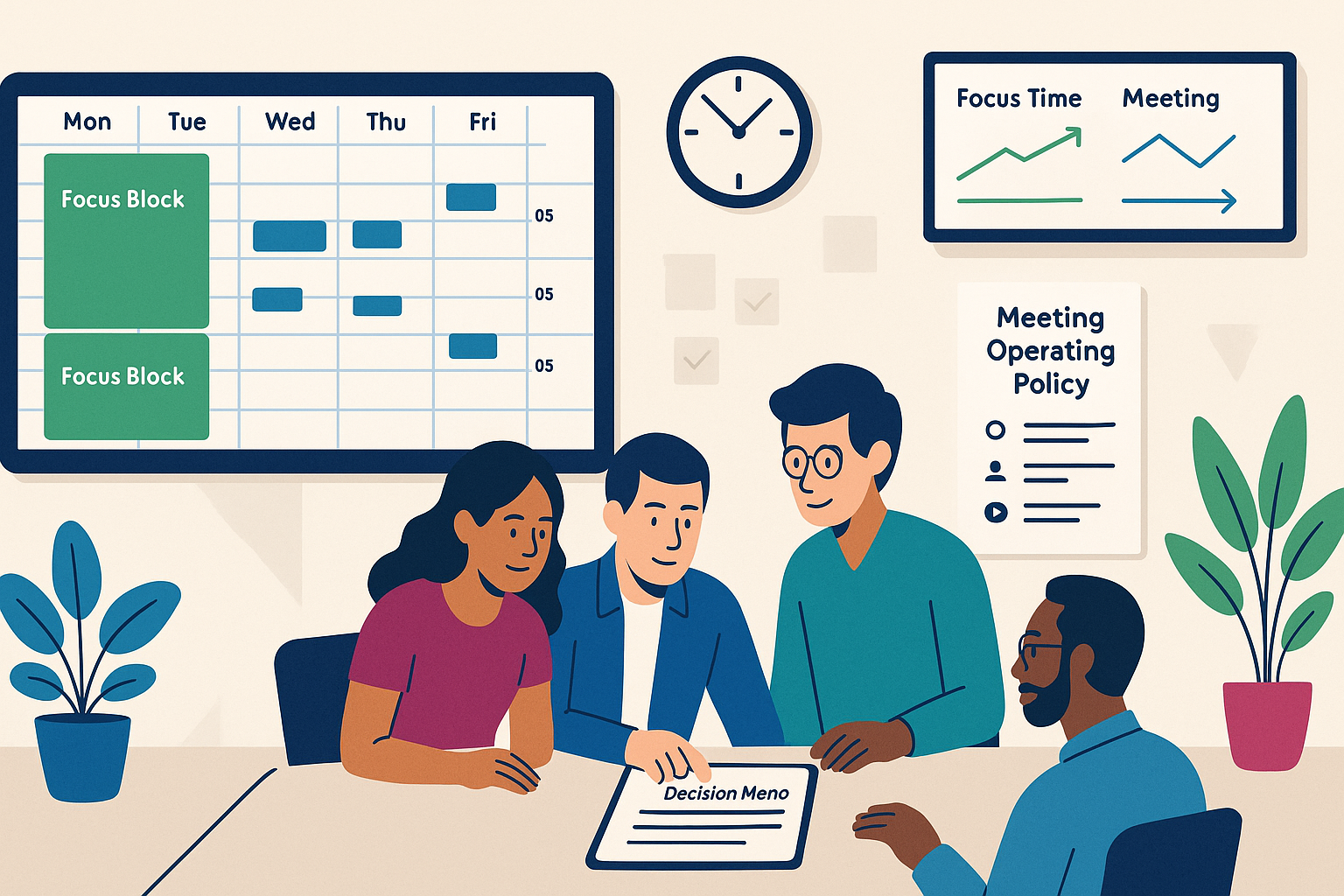
Tame Meeting Overload, Protect Focus: Rules, Rituals, Metrics
Introduction: You do not have a meeting problem, you have a system problem
If your calendar looks like a game of Tetris you are not alone. Meeting overload is not solved by asking people to be more disciplined. It is solved by reengineering how work is decided, coordinated and reviewed. The goal is simple. Protect focus so that hard problems get solved and decisions move faster. This playbook gives you the rules, rituals, templates and metrics that leaders can implement in 30 days.
The hidden cost of meeting overload
Every invitation looks harmless. In aggregate they destroy focus, fragment attention and slow delivery. The direct costs include hours spent and salary burn. The indirect costs are larger. Context switching reduces quality, creates rework and defers decisions. When the calendar becomes the work, strategy drifts and execution stalls.
- Fragmented attention. More transitions lower depth of thought and increase errors.
- Decision latency. Decisions wait for the next slot rather than being made when ready.
- Invisible work. Real work shifts to evenings and weekends, creating burnout.
- Shallow collaboration. Large meetings compress airtime and suppress dissent.
You need an operating model for time. Not slogans about fewer meetings. The following principles drive results.
Principles that protect focus
- Default to asynchronous for information sharing and status updates.
- Reserve meetings for decisions, alignment or creative work that truly requires interaction.
- Constrain the meeting windows in the week. Expand uninterrupted focus blocks.
- Make decisions visible with owners, due dates and documented rationale.
- Instrument your calendar. Track focus time, meeting load and decision throughput.
- Leaders go first. Executives model the behaviours and enforce the rules.
Use the 6Ps lens to fix meetings at the system level
At PerformanceNinja we look at time through the 6Ps only to frame the big picture. Then we get tactical.
- Purpose. Clarify why you meet. Meetings exist to decide, align and create.
- People. Upskill facilitators, note-takers and decision owners.
- Proposition. Prioritise meeting time on the few bets that move value.
- Process. Standardise a taxonomy, agendas, and aftercare for every meeting.
- Productivity. Measure focus time, meeting counts and decision cycle time.
- Potential. Protect time for innovation sprints and deep research.
The tactical playbook: 12 moves to tame overload fast
- Publish a one-page Meeting Operating Policy. State the non-negotiables. Keep it visible and link it in every calendar invite.
- Default durations: 25 and 50 minutes.
- Standard start times: begin at five past the hour.
- No agenda, no meeting. Add objective, decision needed and pre-work in the invite.
- Asynchronous first for updates and information.
- Maximum invitees: seven unless pre-approved.
- Notes within 10 minutes. Actions in the task system, not the minutes.
- Define a meeting taxonomy and required outputs. Categorise each meeting and align on inputs and outputs.
- Decision. Pre-read decision memo. Output is a recorded decision with owner and due date.
- Problem-solving. Clear problem statement. Output is plan, owner and first steps.
- Creative workshop. Clear brief and constraints. Output is shortlist and next test.
- Update. Asynchronous by default. Live only for high risk exceptions.
- 1:1. Coaching, feedback and prioritisation. Output is commitments from both parties.
- Architect the calendar, do not accept it. Protect deep work with time boundaries that everyone sees.
- Maker blocks. Minimum two 2-hour focus blocks per day for engineers, analysts and creators.
- Meeting windows. Concentrate meetings between 10:00–12:00 and 14:00–16:00.
- No-meeting periods. Introduce one half-day per week organisation-wide.
- Office hours. Leaders set fixed drop-in slots to prevent ad hoc requests elsewhere.
- Make asynchronous communication actually work. Replace half your meetings with well-designed async artefacts.
- Decision memos. One page with context, options, recommendation and risks.
- Status posts. Weekly written updates in the work system with RAG signals.
- Short recordings. Five-minute screen capture walkthroughs for demos and updates.
- Response SLAs. For async requests, agree a 24-hour response expectation.
- Clarify decision rights with a DRI model. Every decision has a Directly Responsible Individual who drives to closure.
- Name the DRI in the invite and in the memo.
- Only the DRI can ask for a meeting to decide, and they choose the smallest room possible.
- Disagree then commit. Once decided, stop revisiting unless new data emerges.
- Enforce invite discipline. Treat attendance as a scarce resource.
- Invite only those who must decide, input or execute. Inform everyone else afterwards.
- Optional attendance is meaningful. If optional, the default is do not attend.
- Set a maximum. Seven invitees unless it is a workshop with defined roles.
- Standardise agendas with a simple template. Use a repeatable structure so meetings start fast and end with clarity.
- Purpose. What outcome must we achieve by the end.
- Decision. What exactly we are deciding today.
- Inputs. Links to pre-reads and data. No attachments to the invite.
- Flow. Timeboxed sections, roles and facilitation plan.
- Outputs. Decisions, actions, owners, due dates and communication plan.
- Run the room with clear roles and rituals. Good meetings are facilitated, not chaired.
- Facilitator. Drives flow, protects airtime and enforces timeboxes.
- Scribe. Captures decisions and actions live where work is tracked.
- Timekeeper. Signals pace and keeps the group honest.
- Silent start. Five minutes to read the memo before any discussion.
- Parking lot. Capture off-topic items with an owner and next step.
- Make actions atomic and visible. Do not bury work in minutes.
- Record every action as a task with owner, due date and acceptance criteria.
- Push tasks straight to the team board during the meeting.
- Share the decision and actions within 10 minutes post-meeting.
- Set scheduling and response rules. Reduce friction and speed decisions.
- Response SLA. Accept or decline within 24 hours with a reason.
- Auto-decline. If the invite has no objective or pre-work, decline with a polite template.
- Reschedule guardrails. If key people cannot attend, default to async decision via memo.
- Prune recurring meetings with a 90-day rule. Every quarter, audit and justify or kill.
- Reset or remove. If outcomes have drifted or value is unclear, end it.
- Rotate or lighten. Reduce frequency or rotate attendance to the true core.
- Score. Rate each recurring series for value delivered against time invested.
- Instrument the system with a simple metrics dashboard. What you measure improves.
- Focus time. Average uninterrupted focus hours per person per week.
- Meeting load. Count of meetings per person and total hours.
- Decision cycle time. Days from problem raised to decision recorded.
- Participation health. Distribution of airtime and number of attendees per meeting.
Meeting archetypes with ready-to-use templates
Use these baseline templates and adapt to your context. Keep them short and precise.
Decision meeting
- Length. 25 or 50 minutes.
- Attendees. DRI, two to four subject experts, approver if required.
- Inputs. Decision memo with options and risks. Data and pre-reads linked.
- Flow. Silent read 5. Clarifying questions 5. Discuss trade-offs 10. Decide 5. Communicate next steps 5.
- Outputs. Decision statement, owner, due date, communication plan.
Problem-solving session
- Length. 50 minutes.
- Attendees. Core team only with relevant expertise.
- Inputs. Problem statement, constraints, success criteria.
- Flow. Frame 5. Generate options 15. Evaluate 15. Select and plan 10. Actions 5.
- Outputs. Chosen approach, first experiment, tasks with owners.
Creative workshop
- Length. 80 minutes minimum.
- Attendees. Facilitator, creator group of five to seven, decision-maker available at the end.
- Inputs. Brief, user insight, constraints, inspiration references.
- Flow. Warm-up 5. Diverge 25. Cluster 15. Prioritise 15. Decide 10. Next test 10.
- Outputs. Shortlist, storyboard or prototype plan, owners.
Update and status
- Length. Asynchronous by default.
- Attendees. Readers only. Questions and risks tagged to owners.
- Inputs. RAG update with risks, decisions needed and blockers.
- Flow. If live is necessary, limit to exception handling only.
- Outputs. Resolved blockers, decisions requested, next steps.
1:1
- Length. 25 minutes weekly.
- Attendees. Manager and team member.
- Inputs. Agenda co-created in a shared document.
- Flow. Check-in 5. Priorities 10. Coaching or feedback 8. Commitments 2.
- Outputs. Commitments from both sides, support needed, date of next review.
Retrospective
- Length. 50 minutes per sprint or project milestone.
- Attendees. Whole core team.
- Inputs. Metrics, incidents, wins.
- Flow. What went well 10. What did not 15. Root causes 10. Improvements 10. Owners 5.
- Outputs. Three improvements with owners and deadlines. Visible in the team board.
Scripts to decline or reset meetings without drama
Use plain language and keep emotion out. The aim is to reset expectations and defend focus with respect.
- Missing objective. "Thanks for the invite. To protect focus, we accept meetings with a stated outcome and pre-reads. Please add the decision needed and any pre-work, then re-send if a live discussion is still required."
- Too many attendees. "To keep this efficient, suggest we limit to decision-makers and one subject expert per domain. Happy to read the notes afterwards."
- Prefer async. "This looks like an update. Could we switch to an async post with risks and decisions requested. I will respond within 24 hours."
- Schedule conflict. "Cannot attend within the meeting windows this week. If urgent, please share a decision memo and I will comment today."
Tooling and automation to support the system
Do not buy your way out of a behaviour problem. Use simple settings and rules to make the right behaviours the default.
- Calendar defaults. Set 25 and 50 minute slots and five-minute offset starts.
- Booking rules. Only allow meetings in the designated windows.
- Auto-decline rules. Decline invites without an objective or pre-reads.
- Task integration. Send actions to the work board during the meeting, not after.
- Templates library. Store agendas, decision memos and scripts in a shared folder.
- Focus analytics. Use calendar analytics to track focus time and meeting load.
Common failure modes and how to avoid them
- Leaders exempt themselves. If executives ignore the rules, the system collapses. Leaders must model the behaviours and enforce consequences.
- Asynchronous theatre. People post updates but then schedule a meeting anyway. Hold the line. Live time is for decisions, not reading.
- Bloated workshops. Creativity time becomes a free-for-all. Use small groups, strong facilitation and strict timeboxes.
- Drift in recurring series. Without a quarterly audit, meetings become rituals without results. Prune ruthlessly.
- Action leakage. Decisions die in the minutes. Push tasks into the system during the meeting.
Executive responsibilities that make this stick
Leaders set constraints that unlock performance. Protecting focus is a leadership act, not an admin task.
- Publish and own the Meeting Operating Policy.
- Audit your own calendar first. Cut 30 percent in two weeks to signal intent.
- Set organisation-wide meeting windows and no-meeting periods.
- Require decision memos for material choices.
- Review the metrics monthly. Celebrate reductions in meeting load and increases in focus time.
The 30-day rollout plan
Move fast, communicate clearly and show results in the first month.
- Days 1–3. Draft the one-page policy. Define taxonomy, defaults and windows. Align the executive team.
- Days 4–7. Configure calendar defaults and booking rules. Publish agenda and memo templates. Run a short training on facilitation and scribing.
- Days 8–14. Pilot in two teams. Enforce async updates and run decision meetings by template. Measure focus time and meeting counts.
- Days 15–21. Expand to all teams. Introduce office hours for leaders. Start the no-meeting half-day.
- Days 22–30. Audit recurring meetings. Kill or reset. Publish first metrics and case studies. Identify further automation opportunities.
Proof you are winning: the signals to watch
Do not rely on anecdotes. Track objective signals that show real change.
- Focus time rises. You see at least 12 hours of protected focus per person per week.
- Meeting count drops. A visible reduction in total meetings and average invitees.
- Decisions accelerate. Faster cycle time from issue to decision recorded.
- Better outputs. Clearer decisions, fewer rework loops and higher quality artefacts.
- Happier teams. Qualitative feedback shows fewer evening hours and better energy.
Closing: Treat time as your scarcest strategic asset
The best organisations treat calendars like capital. They invest where it multiplies value and cut anything that does not. Tame meeting overload by design, not by wishful thinking. Protect focus with rules, rituals, templates and metrics. Leaders who master the art of organisational leadership do not ask for fewer meetings. They build an operating model for time that makes deep work normal and fast decisions routine.
Next Steps
Want to learn more? Check out these articles:
Keep Culture Strong as You Scale: A Guide for Leaders
Lead Like Special Ops: A Tactical Guide for Civilian Leaders
Measuring Organisational Health Beyond Engagement Scores
To find out how PerformanceNinja could help you, book a free strategy call or take a look at our Performance Intelligence Leadership Development Programme.




